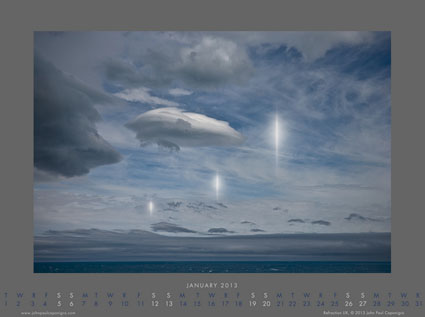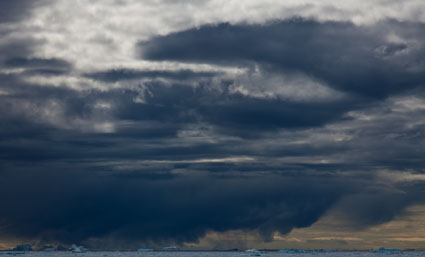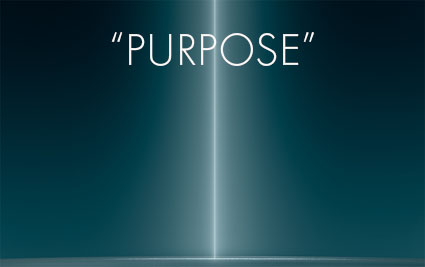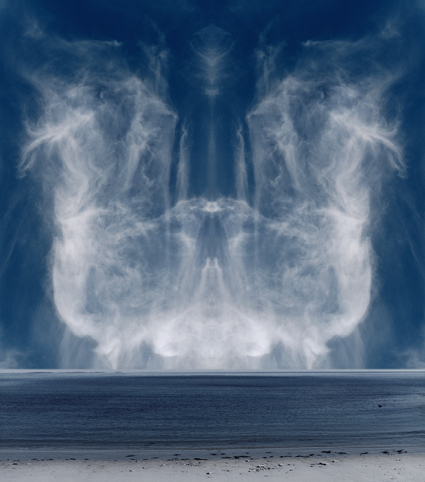Free January Desktop Calendar

My free January Desktop Calendar is available now.
Download it here !

My free January Desktop Calendar is available now.
Download it here !

At the end/beginning of every year I make plans for the coming year. Doing this consistently has helped me be more personally fulfilled and professionally productive.
Here are five resources that will help you do this too.
1 Make A Bucket List
Identify the actions that are most important to you.
2 Make Plans
Increase your productivity and fulfillment by making a plan.
3 Define A Project
Focus your creative efforts and create an action list to achieve your goals.
4 Developing Personal Projects
Tips on developing, completing, and releasing your personal projects.
5 Keep Current Projects Visible
Create visual touchstones to help you focus and follow through on projects.
6 Getting Things Done
David Allen wrote the definitive resource on Getting Things Done.
Pay close attention to the section on Mission/Goals/Projects/Actions.
Learn more with my free enews Insights.
“Is your school or workplace divided into “creatives” versus practical people? Yet surely, David Kelley suggests, creativity is not the domain of only a chosen few. Telling stories from his legendary design career and his own life, he offers ways to build the confidence to create.
David Kelley’s company IDEO helped create many icons of the digital generation — but what matters even more to him is unlocking the creative potential of people and organizations to innovate routinely.”
Watch more creativity videos here.

For most of us, when it comes to emotions, our thinking is often unclear. Most of us enjoy positive emotions, often looking to things outside rather than inside of us to produce them more frequently and intensely. Most of us dislike negative emotions, denying or repressing them so quickly we make little time to truly understand how they were produced, what we can learn from them, and how to encourage different responses, ones of our own choosing. Because of the volatile nature of emotions, at one time or another and sometimes habitually, many of us repress emotions in an effort to avoid conflict and maintain control. Unsure of where they come from or how they were produced we simply react to our emotions, thinking that they are natural, thus inevitable, or that something outside us produces them, thus we are not responsible for them. Even though our emotions can be highly subjective and individual we think of them as universally justified and even though they often change quickly we think of our habitual reactions to them as unchangeable.
In reality, we’re responsible for our emotions. They’re our reactions. When we find that we tend to react to certain things in predictable ways we may become more interested in learning more about our emotions. When we find that we can choose our reactions we may become more interested in developing our emotions.
Awareness is the first step to developing your emotions. Becoming more conscious of our emotions helps us to understand them better, to be less controlled by them, to choose our responses to them, and even to work with them to reduce, intensify, or even change them. In time, you may even find you respond to other people’s emotions differently.
Simply observe your emotions – and everything that surrounds them.
If you find it challenging to focus on a specific emotion, try bringing to mind an event that evokes it for you.
Don’t judge or attempt to change your emotions – or yourself.
What words would you use to describe an emotion?
Are your emotional reactions linked to specific events in your life or ideas you hold?
Identify the physical sensations in your body that accompany an emotion for you.
Over time, does an emotion stay the same or change in intensity or quality for you?
Do you stay with or return to one emotion more frequently than others?
Do your emotions follow any predictable patterns?
Let your emotions flow, allowing them to persist, change or fade without intervention.
Observe your emotions as if they are only one part of you. While you’re feeling an emotion, it may help to simply state “I am feeling …” which can help increase your awareness of both your active role in their existence and the transitory nature of your emotions.
Reflection LVIII
Reflection LVII
Illumination VI
Illumination II
Illumination VII
Illumination III
Illumination XVII
Suffusion XV
Suffusion XIX
Suffusion XXVI
Suffusion XXI
Suffusion XX
This is a selection of my top 12 images of all time. This selection doesn’t reflect sales, publication, or activities on the web. It simply reflects my opinion. Click on the titles to find out more about each image.
Geography
These images are drawn from three locations – Bolivia’s Uyuni salt flats, Namibia’s Sossusvlei dune files, and Iceland’s Skogafoss waterfall.
Process
These images were all drawn from three separate hour-long sessions each yielding complete individual portfolios. I used to think I’d be lucky if I got one really good image from a shoot, but after a few experiences where more than one really good image was made from a single subject, I cast aside my limited thinking. Now I ask, “How far can I take this?”
Concepts
All of these images come out of a way of relating to the world (all of it) as parts of a living thing into whose fibers we are deeply woven. In addition to changing organic forms, they all have a strong suggestion of breath.
Magnificent Moment
They’re all nominees for my list of most sublime landscape experiences. While standing silently focused on Iceland’s Skogafoss waterfall was the fulfillment of many years of looking for my own original response to a classic subject, and walking in the clouds reflected on the surface of Bolivia’s Uyuni salt flats was the realization of a long-standing dream, few landscape experiences compare to the hour spent flying over Sossusvlei Namibia’s 1,500 foot high coral dunes after a sustained sandstorm – the experience was so penetrating it took me quite some time to clearly see the new directions and new levels it offered.It’s challenging to choose so few images from so many – but it’s insightful. Try selecting your own top 12 images. Try selecting the top 12 images of your favorite artist(s).
View more of my Annual Top 12 Selections here.
Resonance In Blue And Gold I A, Charlottesville, Virginia, 2000
The camera does not see as we see. While it can reproduce the appearance of human vision, it can do so much more. Only two percent of our field of vision is in focus at one moment in time; it can focus one hundred percent of its field of vision. Our angle of vision is less than one hundred eighty degrees; it can be extended up to and even beyond three hundred and sixty degrees in all directions. It can see microscopically and telescopically. It can see in brighter, darker or contrastier light – and even into other portions of the spectrum. It can see in a fraction of a second or over a span of hours, days, months, and even years. With the camera, we have made a marvelous extension of our sense of sight, one that continues to evolve.
I’m fascinated by photographs that reveal more than the eye human eye can perceive. Whenever photographs show me more than I saw, I feel as if a magic trick has been performed. This is one of those photographs. I saw the patterns the rain made in the water but I never saw them like this, until I made the photograph. They were too complex and fast-moving to take in all at once. Because the photograph holds them still, I can spend more time considering them, and my understanding of them grows over time.
While I celebrate the marvelous capabilities of the camera eye, I’m not unmindful of the challenging questions that our use of it raises. At what point do we modify our understanding of our own direct experiences to the documents we create? Which has greater authority? When does a photograph supplant memory? What do we consider to be more factual? What do we consider to be truer?
It’s often said that as you deepen your understanding of something, the number of questions you have about it grows. Over time, I’ve come to love the questions even more than the answers. Sometimes revealing, usually stimulating, always useful, questions can have more than one answer and point the way to many new things.
How many ways can photography help you see and experience more?
How can the ways of seeing you learn through photography be extended to moments when you are not photographing?
Are there ways that photography limits your seeing?
Are there ways that what you have learned from photography limits your seeing?

“Your work is to discover your work and then, with all your heart, to give yourself to it.” – Buddha
“The purpose of life is a life of purpose.” – Robert Byrne
“If you’re alive, there’s a purpose for your life.” – Rick Warren
“Here is the test to find whether your mission on earth is finished. If you’re alive, it isn’t.” – Richard Bach
“Having a sense of purpose is having a sense of self. A course to plot is a destination to hope for.” – Bryant H McGill
“The purpose of a man’s heart are deep waters, but a man of understanding draws them out.” – The Bible (Proverbs 20:5)
“Everyone has his own specific vocation or mission in life … Therein he cannot be replaced, nor can his life be repeated. Thus, everyone’s task is as unique as is his specific opportunity to implement it.” – Viktor Frankl
“It is not our purpose to become each other; it is to recognize each other, to learn to see the other and honor him for what he is.” – Hermann Hesse
“Definiteness of purpose is the starting point of all achievement.” – Clement Stone
“There is one quality which one must possess to win, and that is definiteness of purpose, the knowledge of what one wants, and a burning desire to possess it.” – Napoleon Hill
“One person with a belief is equal to a force of ninety-nine who have only interests.” – John Stuart Mill
“Nothing can resist the human will that will stake even its existence on its stated purpose.” – Disraeli, Benjamin
“The secret of success is constancy to purpose.” – Benjamin Disraeli
“Success demands singleness of purpose.” – Vince Lombardi
“More men fail through lack of purpose than lack of talent.” – Billy Sunday
“The purpose of life is to be defeated by greater and greater things.” – Rainer Maria Rilke
“The only failure one should fear, is not hugging to the purpose they see as best.” – George Eliot
“The soul which has no fixed purpose in life is lost; to be everywhere, is to be nowhere.” – Michel de Montaigne
“When a man does not know what harbor he is making for, no wind is the right wind.” – Seneca
“If you don’t decide what your life is about, it defaults to what you spend your days doing.” – Robert Brault
“The purpose of our lives is to be happy.” – Dalai Lama
“Life finds its purpose and fulfillment in the expansion of happiness.” – Maharishi Mahesh Yogi
“Many persons have a wrong idea of what constitutes true happiness. It is not attained through self-gratification but through fidelity to a worthy purpose.” – Helen Keller
“The way you get meaning into your life is to devote yourself to loving others, devote yourself to your community around you, and devote yourself to creating something that gives you purpose and meaning.” – Mitch Albom
“No man or woman is an island. To exist just for yourself is meaningless. You can achieve the most satisfaction when you feel related to some greater purpose in life, something greater than yourself.” – Denis Waitley
“This is our purpose: to make as meaningful as possible this life that has been bestowed upon us; to live in such a way that we may be proud of ourselves; to act in such a way that some part of us lives on.” – Oswald Spengler
“It is essential that we enable young people to see themselves as participants in one of the most exciting eras in history, and to have a sense of purpose in relation to it.” – Nelson Rockefeller
“Be the change you want to see in the world.” – Mahatma Gandhi
“The purpose of education is to replace an empty mind with an open one.” – Malcolm Forbes
“The only thing that interferes with my learning is my education.” – Albert Einstein
“The greatest enemy of knowledge is not ignorance, it is the illusion of knowledge.” – Stephen Hawking
“The essence of the independent mind lies not in what it thinks, but in how it thinks.” – Christopher Hitchens
“The whole problem with the world is that fools and fanatics are always so certain of themselves, and wiser people are so full of doubts”: – Bertrand Russell
“As far as we can discern, the sole purpose of human existence is to kindle a light in the darkness of mere being.” – Carl Jung
Find more Creativity Quotes here.
Read new Creativity Quotes in my Twitter and Facebook streams.

Be more green!
You can make a difference today!
Make many small changes to make one big change!
And you’ll save a lot!
Take action now!
Here’s one idea.
Recycle your Old Cell Phones
We have all heard the call to recycle our old cell phones. We have heard that doing so can save us energy, resources and keep dangerous materials such as like lead, mercury, cadmium, brominate flame retardants and arsenic out of landfills and ultimately our precious groundwater.
The fact are staggering. According to the U.S. Environmental Protection Agency (EPA), Americans discard 125 million phones each year, creating 65,000 tons of waste. With the average person in North America changing out their cell phone every 18-24 months, the waste generate from these upgrades have caused cell phone waste to become the fastest growing segment of manufactured garbage in the nation. Sadly, only about 10 percent of the cell phones used in the United States are recycled. If Americans recycled all of the 130 million cell phones that are tossed aside annually in the United States, we could save enough energy to power more than 24,000 homes for a year.
There are several ways to recycle our old phones. One is reuse. The market for refurbished cell phones has grow over the last few decades. Many organization reuse this old equipment for help with their charity and safety programs. Other markets reach out to smaller developing countries to provide phones where they would be otherwise unaffordable.
Cell phones are filled with valuable reusable materials all of which can be recovered and reused to make new products. For every one million cell phones recycled, we can recover 75 pounds of gold, 772 pounds of silver, 33 pounds of palladium, and 35,274 pounds of copper; cell phones also contain tin, zinc and platinum. Many of these metals when reclaimed from old phones can be reused in jewelry making, electronics and auto manufacturing. This reclamation saves valuable resources and rescues these metals from landfills.
When the rechargeable cell phone batteries are no longer able to be reused they are able to be recycled to make other rechargeable battery products. The overall recycling of just one cell phone saves enough energy to power a laptop for 44 hours and recycling one million cell phones could save enough energy to provide electricity to 185 U.S. households for a year.
The next time you upgrade to a new cell phone, think before throwing your old one away or tossing it into a drawer. The area for recycling and reuse of these old phones is growing every year. Answer the call and recycle!
Find more resources that will help you take action now here.
Find environmental organizations to support here.
“In her New Orleans neighborhood, artist and TED Fellow Candy Chang turned an abandoned house into a giant chalkboard asking a fill-in-the-blank question: “Before I die I want to ___.” Her neighbors’ answers — surprising, poignant, funny — became an unexpected mirror for the community. (What’s your answer?)
Candy Chang creates art that prompts people to think about their secrets, wishes and hopes — and then share them. She is a TED Senior Fellow.”
Watch more creativity videos here.

Find out more about this image here.
Our bodies, the vessels that carry us through life, are miracles of engineering to be marveled at and provide us gateways to both our minds and our emotions. For much of our daily lives we are unconscious of our bodies. When we do become aware of our bodies, our awareness is usually highly selective, often focused only in the presence of heightened pleasure or pain, either physical or psychological. Body images, both self-imposed and inherited, often lead us to judge, either inflating or repressing our direct experiences of our bodies. Developing greater body awareness helps reduce these tendencies and increase our understanding of and appreciation for our bodies as a single harmonious system. Tune in to the miracle that is your body.
Try this meditation.
1 Observe the way you sit. What is your experience of your general posture? How are your spine, torso, neck, head, arms and legs positioned? How long can you sustain this before you feel the urge to change positions? What positions are you most comfortable holding for long periods of time? What positions are you uncomfortable holding?
2 Observe the way you stand. What is your experience of your general posture? What is the position of your spine, neck, head, torso, arms and legs? How is your body balanced? Do you find yourself continually making small adjustments to maintain balance? How long do you feel comfortable maintaining this posture before wanting to change it? How often do you want to change it?
3 Observe the way you walk. What is your experience of your general posture? What is the position of your spine, neck, head, torso, arms and legs? What is the sequence of motions your body routinely makes? How do you maintain balance through this range of motions? What rhythms do you naturally tend towards? How do these things change with increased speed or extended time? Apply this type of observation to any repetitive type of motion you tend to make, such as exercise, dance, or yoga.
4 Observe the way you respond with your body to external stimuli. What do you respond to with increased calm? What do you respond to with increased alertness? What do you respond to with increased tension? How many of these responses are you typically consciously aware of? Are any of your responses surprising to you?
Spend a little time in isolation observing your body with minimal outside distractions. Later, extend your practice to increasing body awareness with increased external stimuli. Try to make this kind of observation a habit. With practice, you’ll find that your awareness of your body will increase, with little or no need for mental direction, growing more frequent, durable, and more deeply felt.
Learn more about meditation with these resources.

